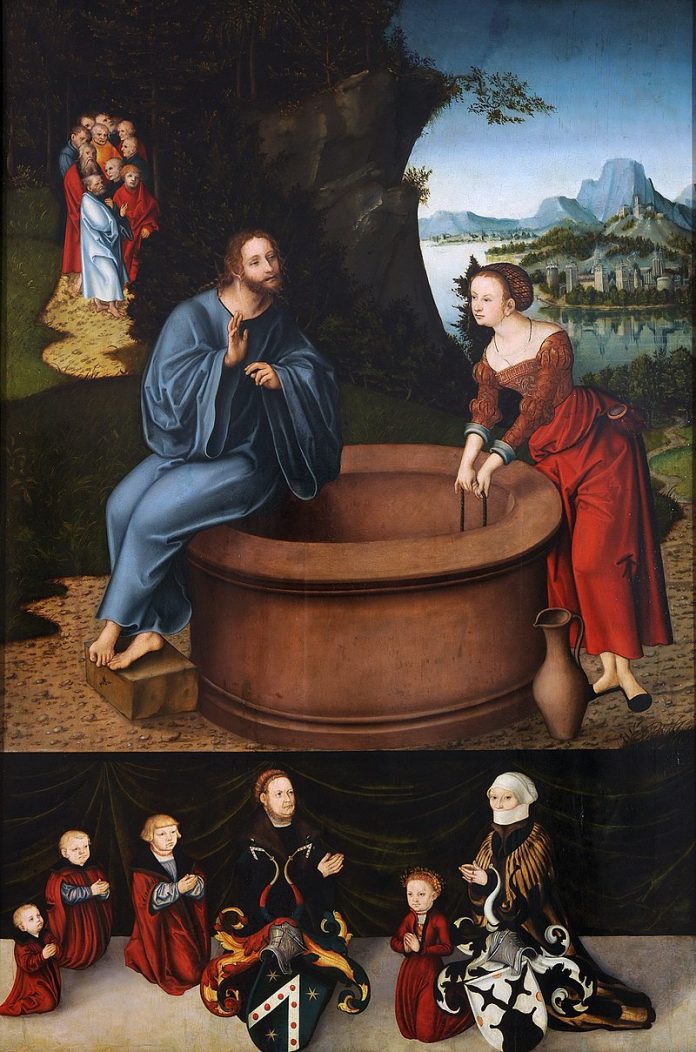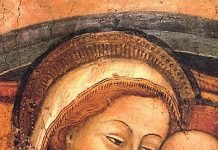As we journey through the beautiful season of Lent the Church has provided us with some magnificent Gospel readings. In the First Sunday of Lent our Gospel is from Matthew (4.1-11) and we hear about Jesus going out into the wilderness. After fasting for 40 days and 40 nights, Jesus was tempted by Satan to turn stones into loaves of bread, to throw himself off the top of a temple, and to fall down and worship the evil one. We know Our Lord rejected Satan’s temptations and this passage conveys that the 40 days of Lent is a time for us to grow closer to Jesus and to further appreciate how His humanity incorporates us into His divinity.
The divinity of Jesus was very apparent in our Gospel reading last Sunday as Matthew described the Transfiguration (17.1-9). Jesus led His apostles Peter, James, and John up a mountain and underwent a wondrous change in appearance as His face shone like the sun and His garments became dazzling white. God the Father’s voice was heard, stating that Jesus was His beloved Son. As Jesus and the apostles came down the mountain Jesus ordered them not to tell anyone about this vision until after His glorious Resurrection.
And today we hear about Jesus meeting a Samaritan woman at a well (John 4.5-42). He was in the Samaritan city of Sychar and, having grown tired by his journey, sat down and asked the woman to give Him a drink of water from the well. It was around noon. Though we are told nothing about her facial expression, she likely had a look of utter astonishment as she asked Jesus, “How is it that you, a Jew, ask a drink of me, a woman of Samaria?” (9a)
The woman’s amazement was rooted in the centuries of hostility between Jews and Samaritans. Some 700 years prior to the Incarnation, the foreign Assyrian empire conquered the ten northern tribes of Israel. Many Jewish people were deported at this time but, among those who stayed in Samaria, there was widespread intermarriage with the pagan Assyrians.
These mixed people, known as Samaritans, developed religious practices that rivaled the Jewish traditions in the southern city of Jerusalem, as they established their own temple and priesthood. Consequently, there was much tension between Jews and Samaritans which carried on to New Testament times, as both groups sought to avoid interaction with the other, including in matters relating to eating and drinking.1, 2 Given all this, the woman’s consternation at Jesus asking for water is most understandable.
Yet Jesus was no ordinary Jewish man, and He said to the women “If you knew the gift of God, and who it is that is saying to you, ‘Give me a drink,’ you would have asked him, and he would have given you living water” (10). The woman interpreted this “living water” as flowing water, which would have been much more refreshing than stagnant well water. But Jesus was speaking about the Holy Spirit and how true refreshment, true life, is found in Him.3
As their dialogue continued, Jesus slowly revealed His divinity; He told the woman to call her husband but she told Him that she had no husband. To this Jesus says she is correct in saying she has no husband for she has had five husbands and the one she is currently with now is not her husband. We can imagine how astounded the woman must have been as Jesus communicated some of His in-depth knowledge about her personal life. And yet, in a seemingly calm manner, she said, “Sir, I see that you are a Prophet” (19).
Clearly, this woman had lived a tumultuous life and the fact she had multiple marriages and was now living with a man who was not her husband would have led to her experiencing much social rejection. This may explain why she came to draw water from the well around noon. In various Old Testament passages, the women would typically draw water from a well either in the morning or in the evening – when it was cooler. But this woman was all by herself in the midday heat gathering water, which suggests she was isolated from her community.4
Remarkably, the woman’s sins and difficulties reflect the historical wrongdoings and struggles afflicting the Samaritan people. The Old Testament’s Second Book of Kings (17:24-31) describes how the king of Assyria brought five foreign tribes into the northern kingdom of Israel who intermarried with the Jewish people that remained there following the Assyrian conquest. These foreign pagans introduced five false gods that were individually called Baal, a Hebrew word meaning “lord” or “husband.” The Jewish prophets rebuked the Samaritans for worshipping these false gods, rightly stating they had abandoned their true Covenant husband, the Lord God. Thus, the woman’s five husbands represented the five false gods of the Samaritans and her fateful meeting with Jesus highlights He is the divine husband or bridegroom who has come to wed His bride. And Jesus’s bride is not only the Samaritans in northern Israel and the Jews in the south but all people everywhere who belong to His Church. We are all called to be in union with the Risen Lord Jesus!5
Jesus’s gentle and merciful revelation to the women caused her to focus less on the water and more on the spiritual destiny of the Samaritans and all people. She said to Him, “I know that the Messiah is coming” and to this Jesus responded, “I am [H]e, the [O]ne who is speaking to you” (vv. 25-26). It was at this point that the woman realized she had encountered the Divine. She left her water jar and went back to the city, crying out “Come and see a man who told me everything I have ever done” (vv. 28-29)!
What a marvelous event! The woman had a life-changing encounter with Jesus and without hesitation she began to spread the Good News! Jesus knew her entire past, everything about her, but He did not condemn her; instead, He offered her forgiveness, healing and grace.
The renowned Church Doctor St. Augustine commented that the water jar left by the woman represents our fallen nature that seeks worldly pleasures which never satisfy. Encountering Jesus moves us, like the Samaritan woman, to leave behind our attachment to worldly cares and become one of His courageous and committed disciples.6
As we further consider how this passage relates to our own spiritual journey, it is crucial to note how Jesus reached out to the Samaritan woman – He did not wait for her to come to Him. Instead, Jesus travelled to Samaria, sat by the well, and began speaking to the woman when she came along. This revealed His divine nature, as our infinitely loving God takes the initiative by continuously calling us to a closer relationship with Him.7 As the Scriptures say, “[w]e love, because [H]e first loved us” (1 John 4:19).
We love because God first loved us. Just as Jesus first loved the Samaritan woman and invited her to encounter Him, so does He first love each one of us and invites us to a relationship with Him. Like the woman at the well, we are wounded by our own sins and we live in a culture that has sharply deviated from revealed truth and right reason. In fact, when we consider how Canada is the only democratic country in the world with no legal restrictions on abortion,8 has arguably this planet’s most permissive laws surrounding euthanasia,9 and has criminalized consensus-based interventions aimed at helping a gender-confused person identify with his or her biological sex10, it is evident our contemporary society is deeply entrenched in diabolical error.
Nevertheless, we are most blessed since the Risen Lord Jesus – who knows everything we have ever done as well, loves us infinitely. He does not wait for us to come to Him. Instead, He stands at the door of our minds and hearts and knocks. If we open the door, He will forgive, heal, guide, and strengthen us so that we may live out His saving truth within a culture that is growing increasingly anti-Christian (Rev 3: 20).
Moreover, Jesus does not knock at our spiritual door only once or twice – He is constantly inviting us to a stronger union with Him. And yet with all our worldly distractions it is so easy to overlook this invitation, it is so easy to miss His knocks. That is why an ongoing life of prayer and the Sacraments of Confession and Communion are so vital. Prayer amplifies the graces we receive from participating in the sacraments, and participating in the sacraments further deepens our prayer lives.11 Through this God-filled combination we truly drink the water that quenches all thirst. For this let us give thanks, and let us give thanks that we love, because He first loved us (1 Jn 4:10).
Sources
1 Ignatian Catholic Study Bible – New Testament, p. 168.
2 Brant Pitre, The Mass Readings Explained. Third Sunday in Lent: Year A (Part one), p. 3.
3 Ignatian Catholic Study Bible, Ibid.
4 Brant Pitre, The Mass Readings Explained. Third Sunday in Lent: Year A (Part one), pp. 5-6.
5 Ignatian Catholic Study Bible, Ibid.
6 Ignatius Catholic Study Bible – New Testament, p. 169.
7 Catechism of the Catholic Church. 604.
8 Source: https://weneedalaw.ca/wp-content/uploads/2020/10/WNAL-PositionPaper2020-NoAbortionLaw.pdf ( Retrieved March 8, 2023).
9 Source: https://nypost.com/2022/08/11/disturbing-experts-troubled-by-canadas-euthanasia-laws/ (Retrieved March 8, 2023)
10 Source: https://www.crisismagazine.com/opinion/the-tyranny-of-gender-ideology-in-practice (Retrieved March 8, 2023)
11 Catechism of the Catholic Church.2658.












